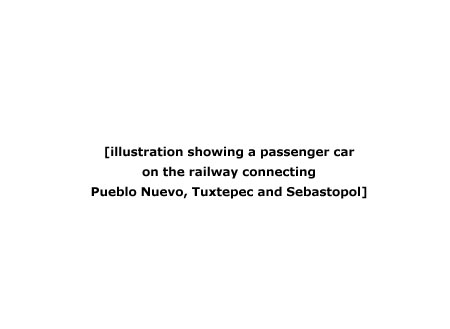The Mysterious Railway at
Tuxtepec
BY
Allen Morrison
The city of Tuxtepec is in a northern corner of Oaxaca state, near its border with Veracruz state, 150 km directly south of the city of Veracruz. It is best known in Mexican history for the Plan of Tuxtepec, which originated there in 1876 and rejected the reelection of presidents. The Ferrocarril de Veracruz al Istmo, which sought to connect the Gulf of Mexico with the Pacific Ocean, reached the area in 1903.
Later railway developments are unclear. A horsecar line was projected in 1903 from Pueblo Nuevo station of the FVI to Tuxtepec [see map], but was not built. In his Tuxtepec Ante la Historia [see BIBLIOGRAPHY below], author Tomás García Hernández states that Ferrocarriles Nacionales, which absorbed the FVI in 1928, opened a 13 km branch from Pueblo Nuevo to Tuxtepec in 1930. The 1930 edition of the Mexican government's Estadística de Ferrocarriles y Tranvías states that a new company, the Ferrocarril de Sebastopol, opened a line that year (of standard 1435 mm gauge) from Pueblo Nuevo to Tuxtepec - and on another 7 km to Sebastopol. EFT also notes in its 1930 edition that Ferrocarriles Nacionales has acquired a 57-seat electric passenger car. The 1931 edition of the EFT indicates that the Ferrocarril de Sebastopol was a freight carrier and had two electric locomotives. The 1932, 1933 and 1934 editions of the EFT repeat this information. The EFT was not published between 1935 and 1950.
EFT does not indicate where Ferrocarriles Nacionales operated its "carro eléctrico de pasajeros" - nor does it indicate that any of FN's 13,300 km of track in the 1930s was electrified. (The Orizaba-Esperanza segment of the Mexico City-Veracruz line that was electrified in 1924 belonged to the Ferrocarril Mexicano). Could FN have operated its electric passenger car over the rails of the Ferrocarril de Sebastopol? The legendary Mexico City tramway historian, Luis León Torrealba [see BIBLIOGRAPHY], thinks that it did. What did the car look like? Where did FN get it? What happened after 1934? The space below is reserved for a photograph that has not yet been found:

In 1944 Tuxtepec was ravaged by a flood which killed over a hundred residents and destroyed many of its buildings. A photograph of the submerged railway station at La Esperanza [see map] shows no overhead wire. But the 1951 Itinerario Oficial de los Ferrocarriles Nacionales lists two viajes (trips) a day between Papaloapan and Tuxtepec. Train Times in Mexico, published in California in 1988 [see BIBLIOGRAPHY], shows two "yard engines" a day between Papaloapan and Tuxtepec, one of them continuing to Sebastopol. The 20 km railway apparently still operates today, serving factories and industries along the line, especially the Fábrica de Papel Tuxtepec ("FAPATUX") at the end of the track in Benito Juárez, a.k.a. Sebastopol.
BIBLIOGRAPHY (in order of publication)
In addition to the works listed below, the author is indebted to the Mexico City tramway historian Luis León Torrealba, who became intrigued with Tuxtepec in the 1950s after stumbling across the 1934 Estadística. León traveled to Tuxtepec and found diesel railcars on the line, but no historical information.
Mexico. Secretaria de Comunicaciones y Obras Públicas. Departamento de Comunicaciones Terrestres. Estadística de Ferrocarriles y Tranvías de Concesión Federal, 1922-1934. Mexico City, 1926-1935. Source of much of the information on this webpage.
Itinerario Oficial de los FF.CC.NN. de México: Cuarto Trimestre, 1951. Mexico City, 1951. "Tabla No. 65 - Papaloapan a Tuxtepec", p. 31.
Train Times in Mexico. Riverside, CA: Mexico Research, 1988. "Table 65 - Papaloapan - Tuxtepec - Presidente Juárez", p. 70.
Mexico. Dirección General de Geografía. Topographic sheet "E14B89 - Tuxtepec". Mexico City, 1984. Excellent map at scale 1:50,000 shows the railway in detail. Basis for the map on this website.
Tomás García Hernández. Tuxtepec Ante la Historia. Tuxtepec, 1989. Brief references to the railroad and the paper mill on pp. 90, 140, 151, 152. Nice street map on unnumbered page.
Tomás García Hernández. La Tragedia de Tuxtepec. Tuxtepec, 1994. The 1944 flood. Photo of the submerged railroad station, p. 79,
return to
INTRODUCTION & INDEX MAP
Copyright © 2003 Allen Morrison - ALL RIGHTS RESERVED
|

